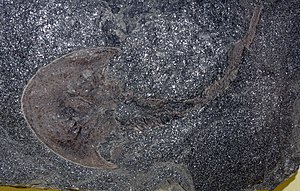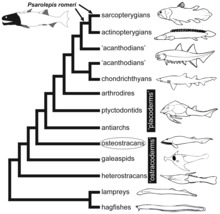Osteostraci
| Osteostraci | ||||||||||
|---|---|---|---|---|---|---|---|---|---|---|

Hemicyclaspis fossil from the Devonian of England |
||||||||||
| Temporal occurrence | ||||||||||
| late Silurian to Upper Devonian | ||||||||||
| 430 to 370 million years | ||||||||||
| Locations | ||||||||||
| Systematics | ||||||||||
|
||||||||||
| Scientific name | ||||||||||
| Osteostraci | ||||||||||
| Lankester , 1868 |
The Osteostraci , also called Cephalaspidiformes , are a group of extinct, fish-like, jawless vertebrates . The oldest fossils of these animals come from deposits of the sea coasts and lagoons of the middle Silurian ( Wenlock series, approx. 430 mya ). In the Lower Devonian , a large number of species that lived mainly in freshwater developed. In the Upper Devonian (approx. 370 mya) they became rare and eventually died out. A total of around 200 species or genera have been found fossilized.
features
Like the Galeaspida and the Pituriaspida, the Osteostraci had an armor-like exoskeleton . Their armor comprised the large, horseshoe-shaped head and torso. In later forms it was reduced and only included the head. In the shell there are eight to ten openings for the gills and in the middle of the top, close together, two eyes. The anatomy of the osteostraci is well known because their cartilage skeleton was surrounded by a thin layer of bone. Among other things, the brain, the round, subordinate mouth and the gills, but also individual veins and nerves are known. Since the shell could not have grown with it, its ossification can only have started in the adult animal.
The part of the body not enclosed by the armor was covered by diamond-shaped scales. Original forms had two dorsal fins, later only one or none at all. The heterocercial caudal fin was supported by the upwardly curved notochord . With the reduction of the shell to the head region, the fish developed paired pectoral fins that were only supported by muscles and which protruded laterally at the end of the head shell. On both sides of the head there were fields from sensory organs with which the animals could perhaps perceive electrical fields or changes in pressure in the water. Because of the heavy head, one adopts a benthic way of life. However, some forms can also have been active swimmers in open water ( pelagic ).
Most osteostraci were about 20 to 40 centimeters long, the smallest form reached 4 centimeters, the largest a length of one meter.
Systematics
Because of the sudden appearance of the osteostraci in the fossil record of the Upper Silurian, it is assumed that they have only developed a fossil-preservable shell since then. Among all the jawless ones, the Osteostraci (perhaps together with the Pituriaspida) share the greatest number of autapomorphies with the jaws (Gnathostomata), especially paired muscular fins, a ring of bones (scleral ring) around the eyes and the heterocercial caudal fin.
The Osteostraci are divided into five main taxa, summarized as Cornuata :
There are also four basic, primitive Osteostraci with the genera Ateleaspis , Aceraspis , Hemicyclaspis and Hirella .
literature
- Robert L Caroll: Paleontology and Evolution of the Vertebrates. Thieme Verlag, Stuttgart 1993, ISBN 3-13-774401-6 .
- Oskar Kuhn: The prehistoric fish-like and fish. A. Ziemsen Verlag, Wittenberg 1967, DNB 457316845 .
Web links
Individual evidence
- ↑ Q. Qu, M. Zhu, W. Wang: Scales and Dermal Skeletal Histology of an Early Bony Fish Psarolepis romeri and Their Bearing on the Evolution of Rhombic Scales and Hard Tissues. In: PLoS ONE. 8 (4), 2013, Art. No. e61485. doi: 10.1371 / journal.pone.0061485 .

